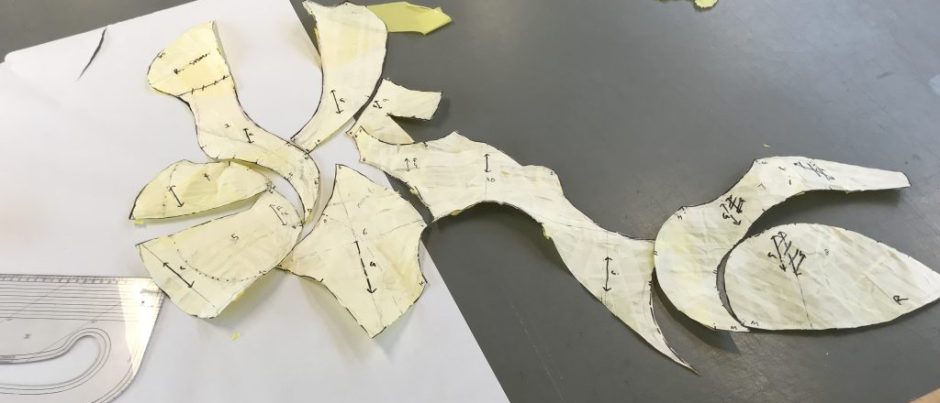My third idea, which after writing the formative assessment intervention outline, I would still like to float, is a more specific intervention.
Having read Haifaa Jawad’s article (2022) about the inaccessibility of sports for many Muslim women in the UK who practice veiling, I was able to make a direct parallel to the barriers created by a lack of private changing space both within the costume studio I primarily work in, and within the wider costume and performance industry.
There are many, intersectional reasons that a lack of private changing space creates a barrier to learning and participating in performance and costume both in the making studio, and backstage, and consequently perpetuates western, Christian, ableist, patriarchal norms and epistemic injustice (Reki, 2023). This includes:
- Religion – as above, relating modesty and gender segregation.
- Gender – those with trans identities are more likely to feel vulnerable in physically exposing spaces (Niemz, 2021).
- Mental disabilities including bodily dysmorphia, anxiety, PTSD, and associated phycological reasons.
- Physical disabilities, which the individual may not wish to expose by removing clothing.
- Cultural norms and expectations.
- Some other physical aspect of the body such as an injury or scar, which the individual may not wish to expose.
- Individual modesty, or bodily shame, related to the above, and other facets of identity.
The emotional, psychological issues which surround modesty, the body, privacy, and shame, are strongly connected to identity. Would like to read around this further.
The instigation of a private changing space would require me to discuss the matter with my colleagues and line manager, in order to obtain the materials and equipment required to instal a changing space. I would need to analyse the current layout of the space, and consider issue including :
- Physical location in the space – it is accessible to all students, is it ‘private’ enough?
- Does it need to be portable or movable, or should it be permanent and static?
- How will I make sure that students know about it, and use it appropriately?
- What dimensions should it be?
- Should there be multiple changing spaces?
- What other elements would it need? – a rail or hooks to hang things off?
- How will it be appropriately lit?
References
Reki, J. (2023) Religious Identity and Epistemic Injustice: An Intersectional Account. Hypatia 38, pp779–800.
Jawad, H. (2022) Islam, Women and Sport: The Case of Visible Muslim Women. [Online]. Available at: https://blogs.lse.ac.uk/religionglobalsociety/2022/09/islam-women-and-sport-the-case-of-visible-muslim-women/
Choudrey, S. (2016) Inclusivity – Supporting BAME Trans People [Online]. Gender Identity Research & Education Society, 14 February. Available from: https://www.gires.org.uk/inclusivity-supporting-bame-trans-people/ (Accessed: 31 May 2024)
Niemz, I. (2021) Trans Inclusive Costume Fittings: Five Tips for Trans Inclusive Fittings [Online Blog]. Society of British Theatre Designers, 18 November. Available at: www.theatredesign.org.uk/trans-inclusive-costume-fittings/ (Accessed: 31 May 2024)
Bibliography in progress
Mirza, H. S. (2018) Black Bodies ‘Out of Place’ in Academic Spaces: Gender, Race, Faith and Culture in Post-race Times. In Dismantling Race in Higher Education, Eds. Arday, J & Mirza, H. S. Switzerland: Palgrave Macmillan. pp 175-195. Available at: https://moodle.arts.ac.uk/mod/resource/view.php?id=1178945
Anderson, C. (2024) Inclusifying the Rehearsal Room: Creating Accessible and Accommodating Theatrical Spaces for Young People. Graduate Thesis and Dissertation 2023-2024. 176. Available at: https://stars.library.ucf.edu/etd2023/176 (Accessed: 31 May 2024)
Beemyn, B. G. (2005). Making Campuses More Inclusive of Transgender Students. Journal of Gay & Lesbian Issues in Education, 3(1), 77–87. Available at: https://www.tandfonline.com/doi/epdf/10.1300/J367v03n01_08?needAccess=true (Accessed: 31 May 2024)
Barrows, L.E., 2023. Transforming Costuming Design: Costuming for the Actor’s Comfort (Doctoral dissertation, University of Central Florida) Available at: https://stars.library.ucf.edu/cgi/viewcontent.cgi?article=2556&context=etd2020 (Accessed 31 May 2024)
